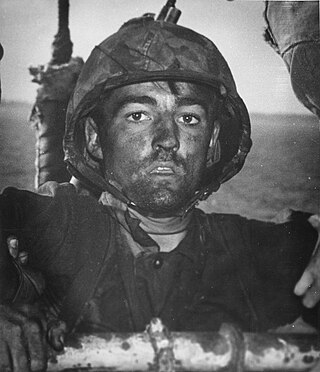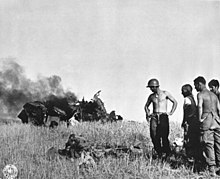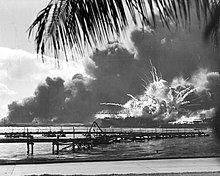Post-traumatic stress disorder (PTSD) is a mental and behavioral disorder that develops from experiencing a traumatic event, such as sexual assault, warfare, traffic collisions, child abuse, domestic violence, or other threats on a person's life or well-being. Symptoms may include disturbing thoughts, feelings, or dreams related to the events, mental or physical distress to trauma-related cues, attempts to avoid trauma-related cues, alterations in the way a person thinks and feels, and an increase in the fight-or-flight response. These symptoms last for more than a month after the event. Young children are less likely to show distress, but instead may express their memories through play. A person with PTSD is at a higher risk of suicide and intentional self-harm.
Psychological trauma is an emotional response caused by severe distressing events that are outside the normal range of human experiences. It must be understood by the affected person as directly threatening the affected person or their loved ones with death, severe bodily injury, or sexual violence; indirect exposure, such as from watching television news, may be extremely distressing and can produce an involuntary and possibly overwhelming physiological stress response, but does not produce trauma per se. Examples include violence, rape, or a terrorist attack.

Combat stress reaction (CSR) is acute behavioral disorganization as a direct result of the trauma of war. Also known as "combat fatigue", "battle fatigue", or "battle neurosis", it has some overlap with the diagnosis of acute stress reaction used in civilian psychiatry. It is historically linked to shell shock and can sometimes precurse post-traumatic stress disorder.
Acute stress reaction and acute stress disorder (ASD) is a psychological response to a terrifying, traumatic or surprising experience. Combat stress reaction (CSR) is a similar response to the trauma of war. The reactions may include but are not limited to intrusive or dissociative symptoms, and reactivity symptoms such as avoidance or arousal. It may be exhibited for days or weeks after the traumatic event. If the condition is not correctly addressed, it may develop into post-traumatic stress disorder (PTSD).
Complex post-traumatic stress disorder is a stress-related mental disorder generally occurring in response to complex traumas, i.e., commonly prolonged or repetitive exposures to a series of traumatic events, within which individuals perceive little or no chance to escape.
A trauma trigger is a psychological stimulus that prompts involuntary recall of a previous traumatic experience. The stimulus itself need not be frightening or traumatic and may be only indirectly or superficially reminiscent of an earlier traumatic incident, such as a scent or a piece of clothing. Triggers can be subtle, individual, and difficult for others to predict. A trauma trigger may also be called a trauma stimulus, a trauma stressor or a trauma reminder.
Memory and trauma is the deleterious effects that physical or psychological trauma has on memory.
Jonathan Shay is an American doctor and clinical psychiatrist. He holds a B.A. from Harvard (1963), and an M.D. (1971) and a Ph.D. (1972) from the University of Pennsylvania. He is best known for his publications comparing the experiences of Vietnam veterans with the descriptions of war and homecoming in Homer's Iliad and Odyssey.

Shell shock is a term that originated during World War I to describe the type of post-traumatic stress disorder (PTSD) that many soldiers experienced during the war, before PTSD was officially recognized. It is a reaction to the intensity of the bombardment and fighting that produced a helplessness, which could manifest as panic, fear, flight, or an inability to reason, sleep, walk, or talk.

Yuval Neria is a Professor of Medical Psychology at the Departments of Psychiatry and Epidemiology at Columbia University Medical Center (CUMC), and Director of Trauma and PTSD Program, and a Research Scientist at the New York State Psychiatric Institute (NYSPI) and Columbia University Department of Psychiatry. He is a recipient of the Medal of Valor, Israel's highest decoration, for his exploits during the 1973 Yom Kippur War.
Jon Elhai is a professor of clinical psychology at the University of Toledo. Elhai is known for being an expert in the assessment and diagnosis of Posttraumatic stress disorder (PTSD), forensic psychological assessment of PTSD, and detection of fabricated/malingered PTSD; as well as in internet addictions.
Because of the substantial benefits available to individuals with a confirmed PTSD diagnosis, which causes occupational impairment, the distinct possibility of false diagnoses exist, some of which are due to malingering of PTSD. Malingering of PTSD consists of one feigning the disorder. Post-traumatic stress disorder (PTSD) is an anxiety disorder that may develop after an individual experiences a traumatic event. In the United States, the Social Security Administration and the Department of Veterans Affairs each offer disability compensation programs that provide benefits for qualified individuals with mental disorders, including PTSD. Malingering can lead to a decline in research and subsequent treatment for PTSD as it interferes with true studies. Insurance fraud may also come about through malingering, which hurts the economy.
PTSD or post-traumatic stress disorder, is a psychiatric disorder characterised by intrusive thoughts and memories, dreams or flashbacks of the event; avoidance of people, places and activities that remind the individual of the event; ongoing negative beliefs about oneself or the world, mood changes and persistent feelings of anger, guilt or fear; alterations in arousal such as increased irritability, angry outbursts, being hypervigilant, or having difficulty with concentration and sleep.
Rachel Yehuda is a professor of psychiatry and neuroscience, the vice chair for veterans affairs in the psychiatry department, and the director of the traumatic stress studies division at the Mount Sinai School of Medicine. She also leads the PTSD clinical research program at the neurochemistry and neuroendocrinology laboratory at the James J. Peters VA Medical Center. In 2020 she became director of the Center for Psychedelic Psychotherapy and Trauma Research at Mount Sinai.
The genetic influences of post-traumatic stress disorder (PTSD) are not understood well due to the limitations of any genetic study of mental illness; in that, it cannot be ethically induced in selected groups. Because of this, all studies must use naturally occurring groups with genetic similarities and differences, thus the amount of data is limited. Still, genetics play some role in the development of PTSD.

Posttraumatic stress disorder (PTSD) is a cognitive disorder, which may occur after a traumatic event. It is a psychiatric disorder, which may occur across athletes at all levels of sport participation.
The Child PTSD Symptom Scale (CPSS) is a free checklist designed for children and adolescents to report traumatic events and symptoms that they might feel afterward. The items cover the symptoms of posttraumatic stress disorder (PTSD), specifically, the symptoms and clusters used in the DSM-IV. Although relatively new, there has been a fair amount of research on the CPSS due to the frequency of traumatic events involving children. The CPSS is usually administered to school children within school boundaries, or in an off-site location to assess symptoms of trauma. Some, but not all, people experience symptoms after a traumatic event, and in serious cases, these people may not get better on their own. Early and accurate identification, especially in children, of experiencing distress following a trauma could help with early interventions. The CPSS is one of a handful of promising measures that has accrued good evidence for reliability and validity, along with low cost, giving it good clinical utility as it addresses a public health need for better and larger scale assessment.
Operational stress injury or OSI is a non-clinical, non-medical term referring to a persistent psychological difficulty caused by traumatic experiences or prolonged high stress or fatigue during service as a military member or first responder. The term does not replace any individual diagnoses or disorders, but rather describes a category of mental health concerns linked to the particular challenges that these military members or first responders encounter in their service. There is not yet a single fixed definition. The term was first conceptualized within the Canadian Armed Forces to help foster understanding of the broader mental health challenges faced by military members who have been impacted by traumatic experiences and who face difficulty as a result. OSI encompasses a number of the diagnoses found in the Diagnostic and Statistical Manual of Mental Disorders (DSM) classification system, with the common thread being a linkage to the operational experiences of the afflicted. The term has gained traction outside of the military community as an appropriate way to describe similar challenges suffered by those whose work regularly exposes them to trauma, particularly front line emergency first responders such as but not limited to police, firefighters, paramedics, correctional officers, and emergency dispatchers. The term, at present mostly used within Canada, is increasingly significant in the development of legislation, policy, treatments and benefits in the military and first responder communities.

Post-traumatic stress disorder (PTSD) can affect about 3.6% of the U.S. population each year, and 6.8% of the U.S. population over a lifetime. 8.4% of people in the U.S. are diagnosed with substance use disorders (SUD). Of those with a diagnosis of PTSD, a co-occurring, or comorbid diagnosis of a SUD is present in 20–35% of that clinical population.
Psychological trauma in adultswho are older, is the overall prevalence and occurrence of trauma symptoms within the older adult population.. This should not be confused with geriatric trauma. Although there is a 90% likelihood of an older adult experiencing a traumatic event, there is a lack of research on trauma in older adult populations. This makes research trends on the complex interaction between traumatic symptom presentation and considerations specifically related to the older adult population difficult to pinpoint. This article reviews the existing literature and briefly introduces various ways, apart from the occurrence of elder abuse, that psychological trauma impacts the older adult population.









